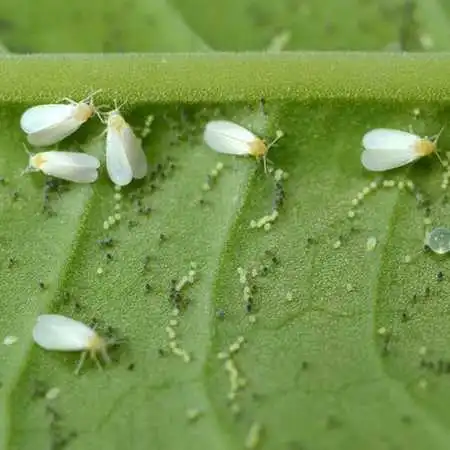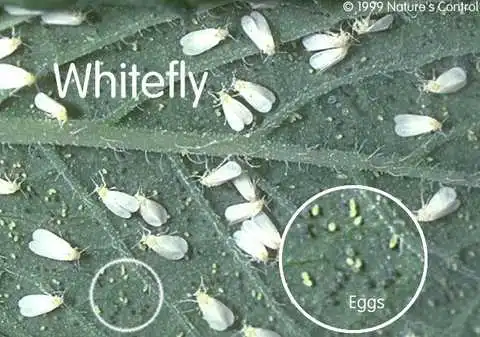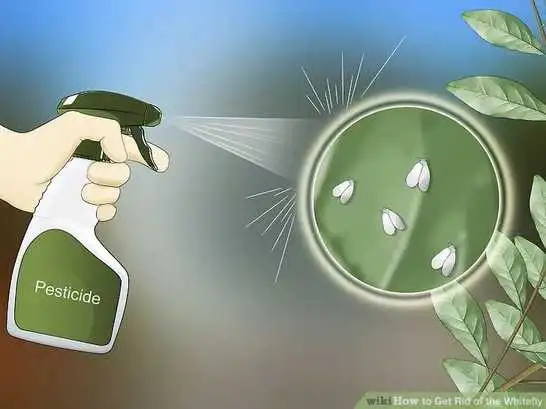Have you ever been startled by a tiny, white cloud of insects taking flight when you brush against your garden plants? If so, you’ve likely encountered the whitefly, a common and persistent garden pest. This guide provides a comprehensive overview of how to identify a whitefly infestation, understand the damage they cause, and implement a multi-pronged strategy to get them under control.
Successfully managing whiteflies requires a combination of vigilance, accurate identification, and a swift response using both natural and, if necessary, chemical methods.

Understanding the Whitefly Menace
Despite their name, whiteflies are not true flies. They belong to the order Hemiptera, which includes aphids, scales, and mealybugs. They get their name from the mealy white wax that covers the adult’s wings and body. Adult whiteflies are tiny, with yellowish bodies and four whitish wings.
Life Cycle and Behavior
Whiteflies thrive in warm weather, and their populations can explode quickly. They lay tiny, oblong eggs on the undersides of leaves, which hatch into wingless nymphs. These nymphs are immobile and feed by sucking plant juices, a behavior that causes the most significant damage. All whiteflies excrete a sugary liquid called honeydew, which can leave a sticky residue on leaves and the growth of a black, sooty mold.

Whitefly Control
Effective whitefly management is a marathon, not a sprint. A multi-tactic approach is far more effective and sustainable than relying on a single solution.
Step 1: Physical and Cultural Methods (Your First Line of Defense)
These are simple, non-toxic methods you can use immediately to reduce whitefly numbers.
- Water Spray: Use a strong jet of water from a hose to dislodge whiteflies, their eggs, and larvae from the undersides of leaves.
- Pruning & Thinning: Remove and dispose of heavily infested leaves. Thinning dense foliage can also improve airflow and make it harder for whiteflies to thrive.
- Vacuuming: In the early morning when whiteflies are sluggish, you can gently vacuum the leaves and stems of infested plants to remove adults and nymphs.
- Reflective Mulches: Placing reflective mulch in your garden can repel whiteflies from vegetable crops.
- Hygiene: Properly dispose of all infested plant waste to prevent the pests from maturing and returning. Do not compost it.
Step 2: Organic and Biological Methods
These methods use natural predators and solutions to control whiteflies without harming the environment.
- Beneficial Insects: Encourage or release natural predators like ladybugs, lacewings, and parasitic wasps, which feed on whiteflies and their eggs.
- Insecticidal Soap: Mix 1 tablespoon of liquid castile soap with 1 gallon of water and spray it on the affected plants. This solution kills soft-bodied insects like whiteflies on contact. Be sure to coat the undersides of leaves.
- Neem Oil: This natural oil acts as a repellent and growth regulator, disrupting the whitefly life cycle. Mix according to the package directions and apply it every few days, testing a small area first to prevent leaf burn (yellowing, browning, or crispy edges).
- Yellow Sticky Traps: These traps can be used to monitor whitefly populations and physically catch adult whiteflies.
Step 3: Chemical Control
Chemical pesticides are often a poor choice for whitefly control. They can kill beneficial insects, harm pollinators, and lead to pesticide resistance, making the whiteflies harder to control in the future.
- Read the Label: If you must use a chemical product, always choose one specifically labeled for whiteflies on your specific plant. Follow all directions carefully.
- Choose Wisely: Opt for insecticidal soaps or horticultural oils before resorting to stronger chemical sprays. Systemic insecticides may be more effective but can have negative impacts on beneficial insects and pollinators.

Prevention of Whiteflies
An ounce of prevention is worth a pound of cure, especially with whiteflies.
- Monitor Regularly: Make it a habit to check the undersides of your plant leaves for early signs of whiteflies. Catching a problem early is the easiest way to prevent a full-blown infestation.
- Keep Your Plants Healthy: Healthy, well-cared-for plants are more resistant to pest damage. Ensure they get the right amount of light, water, and nutrients.
- Manage Soil Nitrogen Levels: High nitrogen levels can attract more whiteflies to plants. Use balanced fertilizers to avoid overly lush, tender growth.
Conclusion
Controlling whiteflies is a process, not a one-time event. Consistency with organic and cultural methods is far more effective and sustainable than resorting to harsh chemicals.




